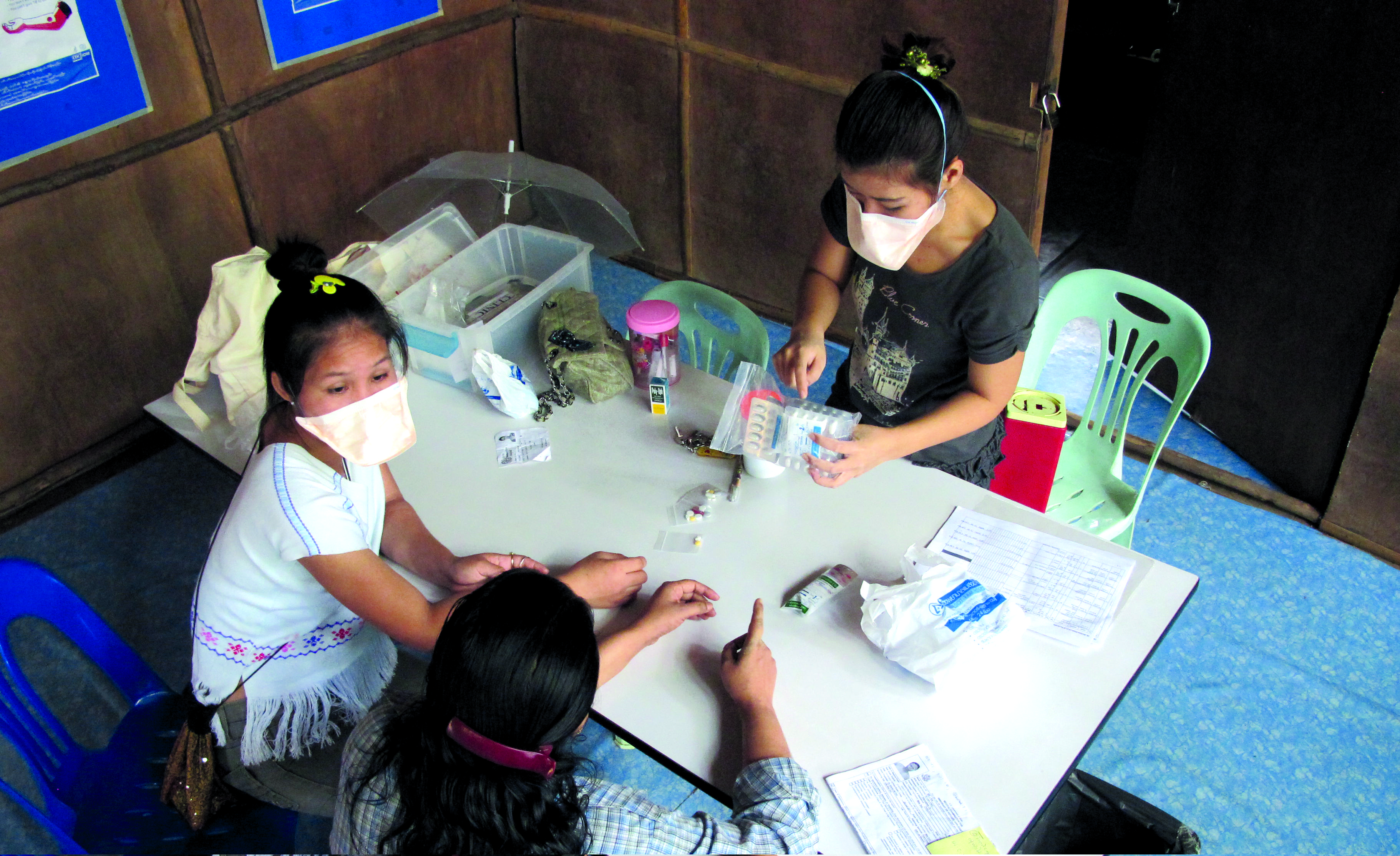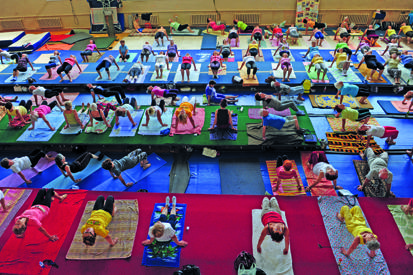A refugee from Myanmar (centre) receives treatment for tuberculosis in the presence of a nurse working for the International Organization for Migration (IOM) and her translator, at Mae Lat camp in Northern Thailand. Once healthy, these refugees can be resettled to a third country.
Well-being is theme of migration report
A new report aims to take a new approach to migration issues by focusing on the health and individual well-being of migrants and their communities.
World migration report 2013: migrant well-being and development, released by the International Organization for Migration last month, focuses not only on migration from lower-income countries to more affluent ones, but also on migration between countries of a similar income, between low- and middle-income countries and from affluent countries to poorer ones.
Six dimensions of well-being are covered: subjective, financial, career, community, social and physical.
“Many reports linking migration and development concentrate on the broad socioeconomic consequences of migratory processes, and the impact of migration on the lives of individuals can easily be overlooked,” said Gervais Appave, one of the editors of the report.
“In contrast, the World Migration Report 2013 views migrants as individuals, exploring how migration affects their quality of life and human development,” he said.
The report comes amidst a growing debate on how the benefits of migration can best be harnessed for development.
It argues that despite progress following the first United Nations General Assembly High Level Dialogue on International Migration and Development in 2006, migration remains inadequately integrated into development frameworks at national and local levels, and public perceptions of migrants and migration are often negative.
The report's assessment of the well-being of migrants is based on the findings of a Gallup World Poll conducted in more than 150 countries.
http://www.iom.int/cms/wmr2013
Mounting Syrian crisis
The number of Syrian people seeking shelter outside their country since the conflict began in March 2011 has passed the two million mark, the United Nations refugee agency (UNHCR) said last month.
Meanwhile, a further 4.25 million people were displaced inside the country, according to data from the United Nation's Office for the Coordination of Humanitarian Affairs. “Taken together, these numbers – amounting to more than six million people – mean that more Syrians are now forcibly displaced than people from any other country,” UNHCR said.
In the last seven months, through WHO coordination, the health sector has reached 3.7 million people in the Syrian Arab Republic with health-care delivery and distribution of medicines and medical material.
The Syrian health ministry said that some 60% or 52 out of 91 public hospitals had limited or no capacity while there were shortages in essential medicines and increased risks of infectious diseases.
There was also an acute shortage of transportation for patients with urgent conditions, with 69% of ambulances damaged (360 out of a total of 520) and 23% (122) out of service, it said. In areas experiencing high levels of violence, health professionals were often unable to report to work due to dangers faced as a result of the insecurity, resulting in severe shortages of health staff.
There was an increased risk of infectious disease outbreaks due to disruptions in vaccination programmes, overcrowding in public shelters due to high levels of internal displacement, damage to water and sanitation infrastructure, and lack of waste management.
Due to shortages in essential medicines for chronic diseases, an increasing number of patients with hypertension, diabetes, cancer, epilepsy, asthma, and renal failure lack access to treatment and life-saving essential medicines, the health ministry said.
Mental health in emergencies
A new WHO report provides guidance for strengthening mental health systems after emergencies, giving examples of how this was done in emergencies in Africa, Asia, the Eastern Mediterranean and Europe.
The report, Building back better: sustainable mental health care after emergencies, was released on 19 August, World Humanitarian Day.
Through case studies from Afghanistan, Burundi, Indonesia (Aceh Province), Iraq, Jordan, Kosovo, Somalia, Sri Lanka, Timor-Leste, and the West Bank and Gaza Strip, it describes how the challenges were overcome and it summarizes the key mental health practices deployed in these situations.
http://www.who.int/mental_health/emergencies/building_back_better
Thousands of residents of the south-western Russian city of Stavropol benefit from free classes at the Vasily Skakun Academy, named after the Olympic gymnastics trainer who set it up. This month's cover photo shows dozens of people at a yoga class there (see news feature about Stavropol on pages 722–723).
Campaign to stop lead poisoning
“Eliminate lead in paint” is this year's theme for the awareness campaign on international lead poisoning this month led by WHO and the United Nations Environment Programme.
During the campaign week, from 20 to 26 October, the two UN organizations will encourage efforts globally to eliminate lead paint by raising awareness about lead poisoning, highlighting countries and partners' efforts to prevent childhood lead poisoning and urging further action to eliminate lead paint.
About 30 countries have phased out the use of lead paints through regulations, but elsewhere lead paint is still widely used. The Global Alliance to Eliminate Lead Paint target is to have all countries eliminate lead paint by 2020, with a target of 70 countries by 2015.
Lead poisoning is entirely preventable, yet childhood exposure to the metal is estimated to contribute to about 600 000 new cases of intellectual disabilities every year. Even though there is wide recognition of the problem and many countries have taken action, exposure to lead, particularly in childhood, remains a key concern for health-care providers and public health officials worldwide.
http://www.who.int/mediacentre/events/meetings/2013/lead_poisoning
Health workers embrace hand hygiene strategy
The implementation of WHO's hand-hygiene strategy in 43 hospitals in Costa Rica, Italy, Mali, Pakistan and Saudi Arabia between 2006 and 2008 significantly improved health-care workers' compliance with best practices, a study showed.
The findings, published in the Lancet in August, support recommendations for use of the WHO strategy worldwide as health-care-associated infections are a major threat to patient safety.
Transmission of such infections is mainly via the hands of health-care workers but compliance with recommendations is often low. However, the study shows that implementation of the strategy can help to overcome this problem.
The study found that implementation had a major effect on compliance of health-care workers across all sites, increasing from 51% before implementation to 67.2% afterwards. Health-care-workers' knowledge also improved at all sites with an increase in the average score from 18.7 to 24.7 after educational sessions.
Two years after implementation, all sites reported ongoing hand-hygiene activities with sustained or further improvement, including national scale-up.
http://www.thelancet.com/journals/laninf/article/PIIS1473-3099(13)70163-4/abstract
14 November: World Diabetes Day
1 December: World AIDS Dayhttp://www.who.int/campaigns/aids-day/2013/event
3 December: International Day of Disabled Persons

 OM/Joe Lowry 2012
OM/Joe Lowry 2012 WHO/Victoria Ivleva
WHO/Victoria Ivleva